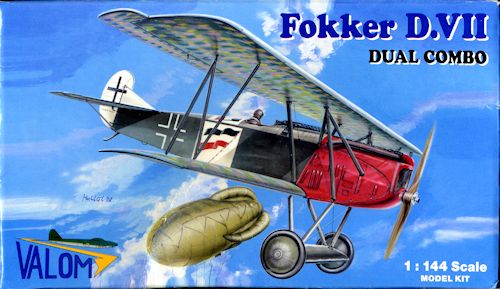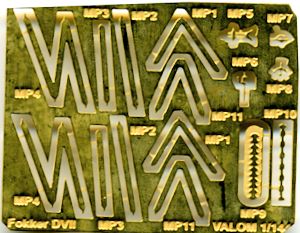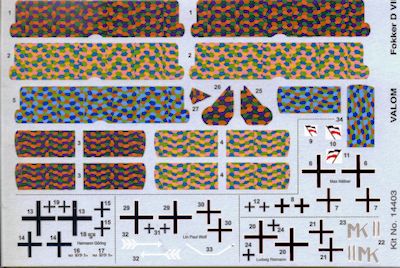
Valom 1/144 Fokker D.VII
| KIT #: | 14403 |
| PRICE: | $ |
| DECALS: | Four options |
| REVIEWER: | Scott Van Aken |
| NOTES: | Short run kit. Two complete kits provided |

| HISTORY |
Considered the finest pursuit aircraft of WWI, the Fokker D.VII was typically, too late to make the sort of impression that was hoped for along the Western Front. So good was this aircraft, that the Armistice agreement specified that this particular aircraft was to be destroyed. Fortunately for many air arms, Anthony Fokker secreted away trainloads of the aircraft to neutral Netherlands where he refurbished these aircraft for use by the Dutch Air Force and several other air arms in the post war period. Several origian airframes are still extant in various museums around the world.
| THE KIT |
 This
is the next offering from Valom in their small WWI series. There are not a lot of
injected WWI kits on the market and so this is a good choice and I hope they do
well with these. Apparently war gamers have found them to be quite nice and
perhaps that was the reason for developing this line. After all, Zvezda has done
very well with its WWII kits of various sizes, though those are specifically for
the wargamer and not as nicely detailed as these.
This
is the next offering from Valom in their small WWI series. There are not a lot of
injected WWI kits on the market and so this is a good choice and I hope they do
well with these. Apparently war gamers have found them to be quite nice and
perhaps that was the reason for developing this line. After all, Zvezda has done
very well with its WWII kits of various sizes, though those are specifically for
the wargamer and not as nicely detailed as these.
For their second choice, it is no surprise that the Fokker D.VII has been chosen. It is a popular modeling subject in all the other scales and one that has minimal rigging (assuming people actually rig these aircraft due to their somewhat small size). In order to provide value for the money, Valom had chosen to put two full kits in each box. In actuality, they could probably market these on header bag kits as both kits fit within a single bag and there is room in the box for probably two additional kit sets.
The molding is very nicely done and well up to Valom's usual standards. All of the detail, including the wing ribs, is engraved and while raised detail may be a bit more accurate, it really doesn't make much difference in this scale.
The plastic bits include the fuselage halves, a complete upper and lower wing, full tailplanes and fin/rudder. The engine is molded onto a firewall which fits into a one-piece engine cowling. The interior consists of a floor, seat, and instrument panel.
 Photo
etch is used for the control stick, all of the wing struts, the tail skid, and
the two side pieces of the landing gear. So are the two pieces used for engine
detail and the throttle piece. The landing gear spreader bar and
wheels are in plastic. So is the prop and the machine guns. Not sure how well
that p.e. tail skid will hold up, but there won't be a lot of weight on it so it
may work well.
Photo
etch is used for the control stick, all of the wing struts, the tail skid, and
the two side pieces of the landing gear. So are the two pieces used for engine
detail and the throttle piece. The landing gear spreader bar and
wheels are in plastic. So is the prop and the machine guns. Not sure how well
that p.e. tail skid will hold up, but there won't be a lot of weight on it so it
may work well.
 Instructions are nicely done and contain three well drawn construction
steps. No rigging diagram is
provided, but
you can figure that out from the box art and it is minimal. There are markings
for four aircraft, and thankfully, Valom has included the lozenge for the upper
and lower wings. One is the box art plane of Max Nather of jasta 62 in the last
months of the war. An all white version of Herman Goering is also provided from
JG 1 in late 1918. WIth the white arrows on a blue fuselage is Paul Wolf's plane
with Jasta 13. The final one has a greenish fusleag and the initials MK on the
fuselage. This is the aircraft of Ludwig Reimann of Jasta 78b in 1918. The
decal sheet is nicely printed and actually rather large, thanks to the wing
lozenge.
Instructions are nicely done and contain three well drawn construction
steps. No rigging diagram is
provided, but
you can figure that out from the box art and it is minimal. There are markings
for four aircraft, and thankfully, Valom has included the lozenge for the upper
and lower wings. One is the box art plane of Max Nather of jasta 62 in the last
months of the war. An all white version of Herman Goering is also provided from
JG 1 in late 1918. WIth the white arrows on a blue fuselage is Paul Wolf's plane
with Jasta 13. The final one has a greenish fusleag and the initials MK on the
fuselage. This is the aircraft of Ludwig Reimann of Jasta 78b in 1918. The
decal sheet is nicely printed and actually rather large, thanks to the wing
lozenge.
| CONCLUSIONS |
Whether war gaming or just a 1/144 scale enthusiast, this kit would be a great choice. Note that you will have to drill the holes in the wing for the etched struts, but there are locator marks. You'll also have to provide the struts for the tailplanes, but this is all typical short run stuff.
October 2013
Review kit courtesy of Valom. For more information, visit the link.
If you would like your product reviewed fairly and fairly quickly, please contact the editor or see other details in the Note to Contributors.
Back to the Previews Index Page